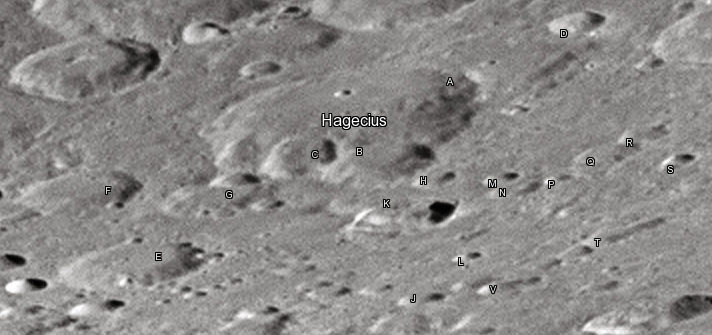Hagecius (crater) on:
[Wikipedia]
[Google]
[Amazon]
Hagecius is a lunar impact crater in the southeastern part of the Moon's near side. It was named after 16th century Czech naturalist

 By convention these features are identified on lunar maps by placing the letter on the side of the crater midpoint that is closest to Hagecius.
By convention these features are identified on lunar maps by placing the letter on the side of the crater midpoint that is closest to Hagecius.
Tadeáš Hájek
Tadeáš Hájek z Hájku () (1 December 1525 in Prague – 1 September 1600 in Prague), also known as Tadeáš Hájek of Hájek, Thaddaeus Hagecius ab Hayek or Thaddeus Nemicus, was a Czech naturalist, personal physician of the Holy Roman ...
(Latinized as Thaddaeus Hagecius). This crater forms a triangular formation with the craters Rosenberger to the north-northwest and Nearch to the west-northwest. Like both of these craters, Hagecius has undergone erosion from subsequent impacts, and its outer rim is worn and irregular. The southeastern rim in particular is overlaid by three smaller craters designated Hagecius C, B, and G.
The interior floor of Hagecius is a level plain with no significant rises. There is a small craterlet to the northwest of the midpoint, and a few tiny craterlets marking the southeastern half of the floor. About a third of the interior floor on this side is also overlaid by the outer ramparts of the three satellite craters mentioned above.
To the northeast of Hagecius is the crater Biela, a younger formation with more distinctive features.
Satellite craters

 By convention these features are identified on lunar maps by placing the letter on the side of the crater midpoint that is closest to Hagecius.
By convention these features are identified on lunar maps by placing the letter on the side of the crater midpoint that is closest to Hagecius.
See also
*1995 Hajek
1995 Hajek, provisional designation , is a metallic asteroid from the middle region of the asteroid belt, approximately 13 kilometers in diameter.
It was discovered on 26 October 1971, by Czech astronomer Luboš Kohoutek at the Bergedorf Observ ...
, asteroid
References
* * * * * * * * * * * {{refend Impact craters on the Moon